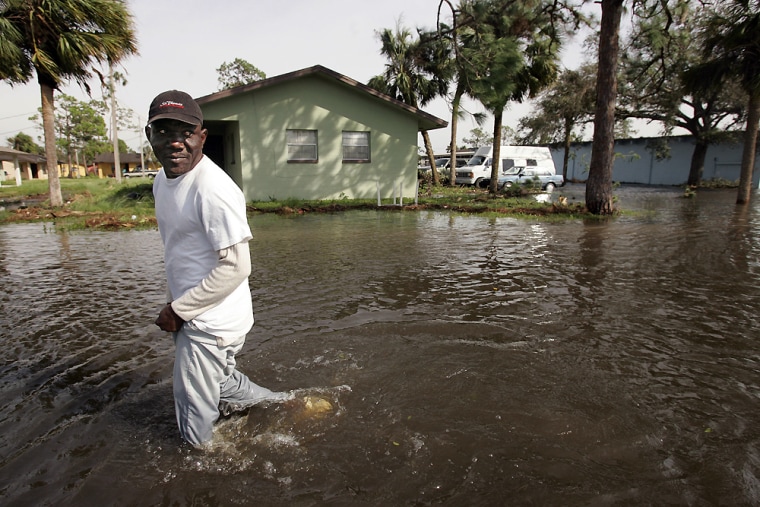Shoppers can expect to pay more than twice as much for tomatoes and peppers, especially in grocery stores along the East Coast, for the next two months because Hurricane Wilma flooded fields and tore through crops in Florida.
Florida growers who choose to replant destroyed crops likely won't be able to bring their produce to market for another two months. This will cause a temporary shortage of tomatoes and peppers since the state provides more than half of the nation's fresh vegetables between the months of November and February, industry officials said Wednesday. Only California annually produces more fresh vegetables than Florida.
"As the supermarkets come to expect those tomatoes and don't get them those prices are going to rise," said Ray Gilmer, a spokesman for the Florida Fruit & Vegetable Association.
After last year's hurricanes ruined some Florida vegetable crops, the price of tomatoes went from $1.50 to $2 a pound to as much as $4 to $5 a pound. But the price didn't go back down right away, even after the Florida crop returned to normal in early January.
"Prices go up quickly but drop slowly," Gilmer said.
Wilma peeled off the corrugated steel roofs of vegetable packinghouses, and flooded tomato and pepper fields. Winds ripped off the plastic coverings of greenhouses, exposing delicate baby tomato and pepper plants to the burning rays of Florida sunshine after the storm.
"This is the worst time of the year for something like this to happen since we're just starting the season," said Pat Naughton, a customer service manager for TransGro, which has more than a dozen acres of greenhouses outside Immokalee. "This is our busiest time of the year."
Last year, Charley and three other hurricanes caused $2 billion to $3 billion in damages to crops and infrastructure. Agriculture officials said that it's too early to assess the destruction from Wilma but that it would likely be in the hundreds of millions of dollars.
Taxpayers again could be helping bail out the losses of Florida growers. Last year, the U.S. Department of Agriculture paid Florida growers about $600 million as compensation for their losses, said Terry McElroy, a spokesman for the state Department of Agriculture and Consumer Services.
The timing for growers couldn't have been worse since many of the plants only had been in the ground since August or September. The hurricane also blew off or flooded the plastic mulch on which the beds of vegetables are planted.
Jamie Williams, an official with the Six Ls agriculture conglomerate, which grows tomatoes, peppers and eggplants in southwest Florida, said much of the company's fields south of Naples were devastated.
"It looks like everything in the ground is a loss," Williams said.
Much of the damage to the vegetable crops was expected to be caused not only by winds but by flooded fields. Vegetable plants start to perish if submerged under standing water in their fields for more than two or three days.
"The plants are drowning right now. The problem is, there's nowhere for the water to go," said John Dunckelman, associate director of the University of Florida's Southwest Florida Research and Education Center in Immokalee. "The vegetables are very sensitive. If we don't get the water out in a day or two, they're gone ... and then it's going to be quite a time before we recover."
Wilma also hit hard the sugar cane fields and warehouses around Clewiston, ornamental nurseries in Miami-Dade County and citrus trees in Hendry and Collier counties, two of the state's largest citrus producing counties. Both counties have about 130,000 acres of citrus. Preliminary reports showed that in some areas up to 15 percent of the fruit crop was blown off trees, according to the Florida Citrus Mutual, the state's lowest citrus growers group.
"Winds knocked a lot of fruit off. We're trying to assess how much," said Peter Brace, a spokesman for Tropicana Products Inc., which buys a third of Florida's orange crop.
Boyd Cruel, a soft commodities analyst with Alaron Trading, said orange juice prices in grocery stores likely won't increase in the short term but may rise if the U.S. Department of Agriculture determines there will be a smaller crop.
Growers also were concerned that Wilma may further spread citrus canker, a bacteria that can weaken citrus plants. The disease almost was eradicated last year, but 2004's hurricanes spread it to the heart of the citrus-growing regions of Florida, forcing state agriculture officials to remove or plan to remove 70,000 acres of citrus.
"We still think we can stop the disease if we stay ahead of it and try to get those trees on ground before they have a chance to spread," said Agriculture Commissioner Charlie Bronson.
The hurricane not only ruined crops but toppled infrastructure, such as the ProSource warehouse in Immokalee, where chemical and fertilizers are stored. The storm caused an estimated $500,000 in damage to the bags of fertilizer and the warehouse roof, parts of which were ripped off.
"It's the worst timing in the world," said warehouse manager Doug Raynor.
